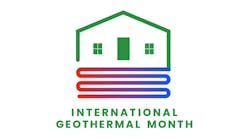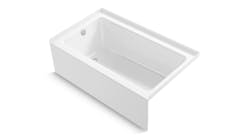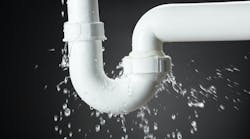Latest from Green
Sponsored
Why Leak Prevention Technology Should Be Standardized in Green Building Construction
By Juliana Hess and Manfield Mandigora, InsureTEK
Research continues to demonstrate the benefits of green building construction—from an environmental perspective and a financial one.
According to the US Green Building Council (USGBC), the initial cost of a green building is only 2% to 3% higher than a non-green counterpart. This initial upfront cost can result in savings of over ten times the initial investment, according to CalRecycle.
Yet, one aspect of green building construction—water conservation—is only now beginning to be discussed in severe terms as leak protection technology becomes more affordable and reliable. The growing problem of water scarcity in some areas of the country is helping drive this conversation as more people become aware of the critical importance of protecting this precious natural resource.
Water loss is a more widespread problem than is commonly acknowledged. One-fifth of all toilets in the United States are estimated to be leaking at any one time, and leaks from taps, toilets and hidden pipes can cumulatively cause 14 out of every 100 gallons of water to go to waste. The water loss is monumental, as are the financial implications, but it has been easier to ignore without proper data.
Managing Risk and Expense
Even more concerning, undetected leaks can escalate into an expensive and even deadly problem for building owners. While the tragic 2021 condominium tower collapse in Surfside, Florida, is the most well-known recent example, thousands of buildings are affected yearly by water damage that can weaken structural integrity, create mold issues, destroy electrical systems and corrode plumbing. Fixing the damage caused by water leakage can add to a building's carbon footprint because of embedded carbon in the cost of reconstruction, making a green building far less environmentally conscious than initially intended.
Water damage is increasingly evolving into an uninsurable risk for many commercial buildings. Over the past two to three years, property insurance deductibles for non-weather-related water damage have skyrocketed, with some doubling or even tripling annually. These escalating deductibles impose a heavy financial burden on building owners.
In numerous cases, the expenses incurred due to these incidents and subsequent repairs quietly eat into incidental budgets, often escaping the scrutiny of senior executives and CFOs. However, when we examine these accumulated costs, the sheer magnitude of expended financial resources becomes glaringly apparent. These expenses, coupled with the resulting damages and liabilities, are substantial and could have been effectively prevented by implementing technology. Especially in uncertain economic times, failing to utilize financial resources more efficiently becomes a missed opportunity.
In essence, building owners unknowingly find themselves acting as self-insurers against water damage, often needing to fully grasp the extent of this financial exposure and the potential for resource optimization through technological solutions. It not only represents a waste of money and resources but also a fiduciary duty to safeguard their properties' financial health and sustainability.
The best solution lies in proactively harnessing available technology to minimize or even prevent leaks before they occur. The most time- and cost-effective approach to achieve this is through seamless integration into the building construction process. As part of a broader sustainability or “green” initiative, this integration promotes the construction of more resilient structures and enhances adaptability in the face of changing climate conditions.
Improvements in Technology
While leak prevention technology has been available in buildings for several decades, its reliability, efficacy and convenience have significantly expanded as its cost has plummeted, making it far more affordable. In contrast with the simple functionality of the earliest water-detecting sensors—if water was detected on a surface, they sent an alarm to the user—today's sensors can use artificial intelligence (AI) and machine learning (ML) to provide a detailed look at water usage patterns and detect leaks quickly, even in areas of a building that were once difficult to monitor. They also learn over time, reducing the likelihood of false alarms.
The earlier AI/ML leak prevention technology is integrated into the design of a building, the more effective it can be. One of the goals of our company, InsureTEK, is to raise awareness about the myriad of benefits of codifying water leak prevention into new building designs.
The abundance of options can be overwhelming for building owners and developers considering leak prevention technology. While sensors are readily available at Home Depot or directly from manufacturers, the lack of comprehensive information regarding sensor reliability, ease of installation, warranty coverage and scalability for large-scale construction projects poses a significant challenge. In an era emphasizing transparency, factors such as the financial viability of technology manufacturers, scalability, supply chain integrity and transparency in origins play a pivotal role in assessing risk.
Comprehensive Solutions
At InsureTEK, our approach extends beyond sensor selection; we aggregate the latest internet-of-things technology available on the market and subject both the devices and their manufacturers to rigorous independent testing. Our evaluation encompasses—to the best of our ability—the quality and reliability of these technologies and the company's financial viability, corporate governance and supply chain resilience. This comprehensive assessment underpins the establishment of a standardized and scalable supply chain and installation process, ensuring consistent quality, irrespective of location.
We have developed a device and manufacturer-agnostic dashboard to streamline the technology selection and implementation process. This tool empowers us to tailor a comprehensive solution that aligns with the unique needs of building owners and developers, reflecting our commitment to mitigating risks and delivering superior quality.
In collaboration with InsureTEK, Arcadis reviews building blueprints and conducts comprehensive on-site surveys to identify and prioritize significant risk areas. We strategically select devices from across our selection of vetted manufacturers based on the specific risk profiles, which allows us to create a tailored solution for each project. Another trusted partner, MasTec, is responsible for managing the installation at locations across North America through a standardized process, then closely monitoring it for quality assurance.
Multiple Advantages
Adopting leak prevention technology not only shields buildings from water damage but also gives building owners leverage when engaging with insurers. While insurers may not consistently lower premiums and deductibles outright, this technology allows building owners to negotiate for the maintenance of premiums or explore agreements where insurers may offer rewards or incentives upon demonstration of risk mitigation.
For contractors, the advantages are multifaceted, ranging from potential cost savings on builder's risk insurance to avoiding additional expenses and project delays stemming from water-related issues. The flexibility and benefits of leak prevention technology extend to insurers, building owners and contractors, providing opportunities for creative and mutually beneficial agreements.
Furthermore, in today's ever-evolving financial landscape, lenders are increasingly incorporating sustainability solutions that promote risk mitigation as a critical factor in assessing the cost of capital. Leak prevention technology seamlessly aligns with sustainability objectives and practices, making green building projects more appealing to lenders and investors, enhancing the financial viability of such projects and underscoring the paramount significance of responsible resource management and risk reduction.
By proactively averting water-related incidents, stakeholders across the board—from building owners, future occupants, contractors, insurers and regulatory authorities—effectively mitigate potential liabilities, penalties and the associated financial burdens. This proactive approach safeguards precious financial resources and paves the way for a more resilient and sustainable future for all parties involved.
Growing Awareness
Leak prevention technology can be likened to fire sprinklers, which are required in all major commercial buildings today but weren't always. Insurance companies spurred this change, which realized the extent of losses due to fire and pushed for stronger fire sprinkler regulations. Additionally, the present landscape sees a growing push from local authorities for building owners to implement measures for mitigating water risks. This dual impetus, both from insurers seeking risk reduction and government authorities safeguarding precious resources, reinforces the inevitability of a similar transformation in water management.
There's a growing change in awareness about establishing standards for leak prevention technology. Not only does it make financial sense for all the stakeholders involved, from contractors to building owners to insurers, it's a simple and effective means of cutting down on unnecessary water usage and conserving this vital resource.
Manfield Mandigora is chief operating officer and Juliana Hess is chief impact officer at InsureTek, a pioneering B2B platform aggregator that integrates building sensors, installation, insurance, financing and artificial intelligence/machine learning to predict, mitigate, and minimize building owners’ loss from water damage and other perils.
Manfield Mandigora | CEO
Manfield Mandigora is the chief operating officer at InsureTEK.
Juliana Hess | Chief Impact Officer
Juliana Hess is the chief impact officer at InsureTEK.


